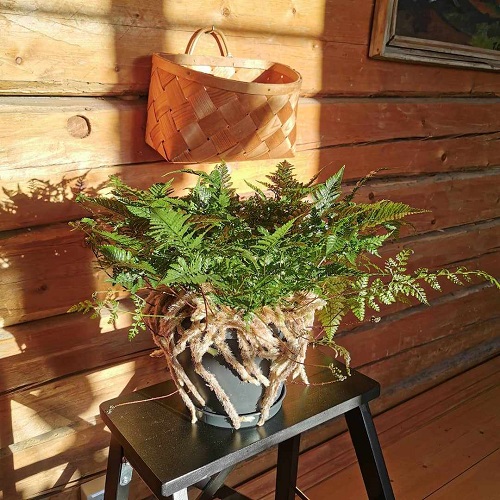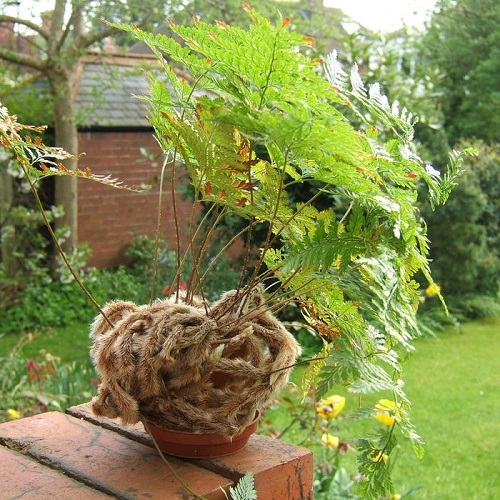Here’s a Rabbit’s Foot Fern Care and Growing Guide you must check out to enjoy this furry houseplant for many years!

The Rabbit’s Foot fern derives its name from the furry tubers that grow on top of the soil and look like a rabbit’s foot. Read on to learn about Rabbit’s Foot Fern Care and Growing Guide.
Botanical Name: Davallia fejeensis
Know all the Best Fern Care Tips here
Rabbit’s Foot Fern Profile
Rabbit’s Foot Fern is long, creeping, and filled with brown, hair-like toothed scales that look like a rabbit’s foot. The tiny leaves are attached to the top of wiry stalks growing from the rhizomes.
The yellow and furry brown rhizomes creep over the container adding to its charm. It makes for a beautiful houseplant, trailing over walls and nearby objects with its lacy fronds.
Learn How to Grow Ferns from Ferns here
Rabbit’s Foot Fern Plant Propagation
The Davallia ferns are easy to propagate via rhizome cuttings in spring.
- Use sharp scissors or pruners to cut off 2-3 inches of the rhizome with 1-2 fronds attached to it.
- Fill an 8-10 inches pot with peat-based mix and place the rhizome on the surface. You can pin it down using a small wire loop.
- Evenly moisten the soil and place the container in a plastic bag. Then, keep it in a spot that receives bright but indirect sunlight for 4-5 hours daily.
- You’ll notice new growth in 6-8 weeks.
Get the Best Fern Propagating Tips here
Choosing the Right Container for Davallia fejeensis
You can start the plant in a 6-8 inch container without any problem. It will be good for 1-2 years. After that, re-pot it into one size bigger pot than the old one, depending on the growth and spread.
Requirements for Growing Rabbit’s Foot Fern

Light
Do not expose the plants to direct sunlight, as it will burn the foliage. If you are keeping the plant near a south-facing window, keep it 2-4 feet away from it. An east-facing location, where the plant gets exposed to the direct mild morning sun for 2-3 hours, will be best.
Soil
A well-draining peat-based soil with a pH of 7 will be good for your fern. Combine 40% garden soil, 30% sand, and 30% peat moss with a fistful of aged manure for the perfect blend. Make sure the medium retains water but doesn’t get soggy.
Water
This fern prefers constantly moist but not soggy soil. Do not let the soil dry out entirely, as it can shrivel the plant and even result in death. Keep an eye on the topsoil and moisten it whenever it dries. Avoid watering the plant daily at all costs.
Temperature and Humidity
Rabbit’s Foot fern grows best at 60-75 F, or 15-23 C. Do not expose the plant to lower than 55 F or 13 C and higher than 80 F or 26 C. Keep it away from cold drafts and AC or heating vents.
This beautiful specimen appreciates comparatively more humidity than other varieties to maintain its dainty fronds. You can keep its pot on a pebble tray filled with water, too.
Learn How to Grow Ferns in Water here
Davallia fejeensis Care

Fertilizer
Feed the plant using a balanced liquid fertilizer, diluted to half its strength, once every 4-6 weeks throughout the growing season. It is best to cut back on feeding from fall to spring. Do not fertilize the plant in colder months.
Overwintering
This fern enters a semi-dormant phase in the winters, and you should cut back on watering and feeding in this period (October-March).
Pests & Diseases
The Rabbit’s Foot fern is prone to common pests such as mealybugs, aphids, whiteflies, and scales. You can use horticultural oil to treat this infestation.
Also, it can develop root rot when the creeping rhizomes get buried instead of covering the top of the soil. Being an epiphyte, this plant draws moisture from the air rather than the soil. Do not overwater the plant to keep fungal diseases at bay.


